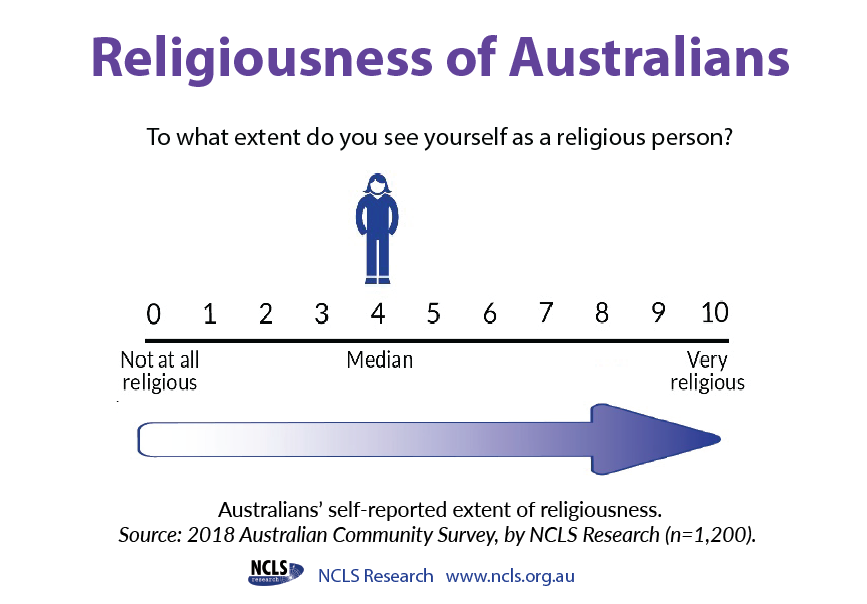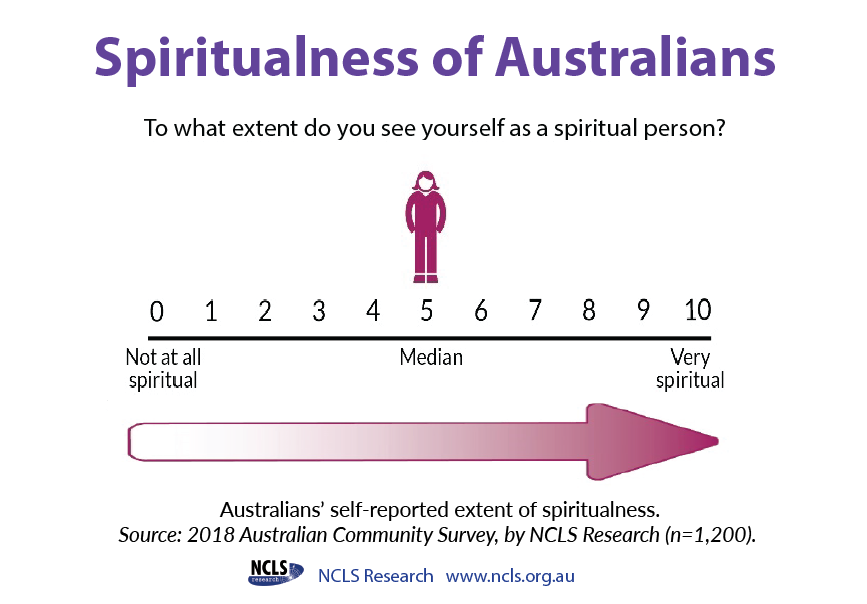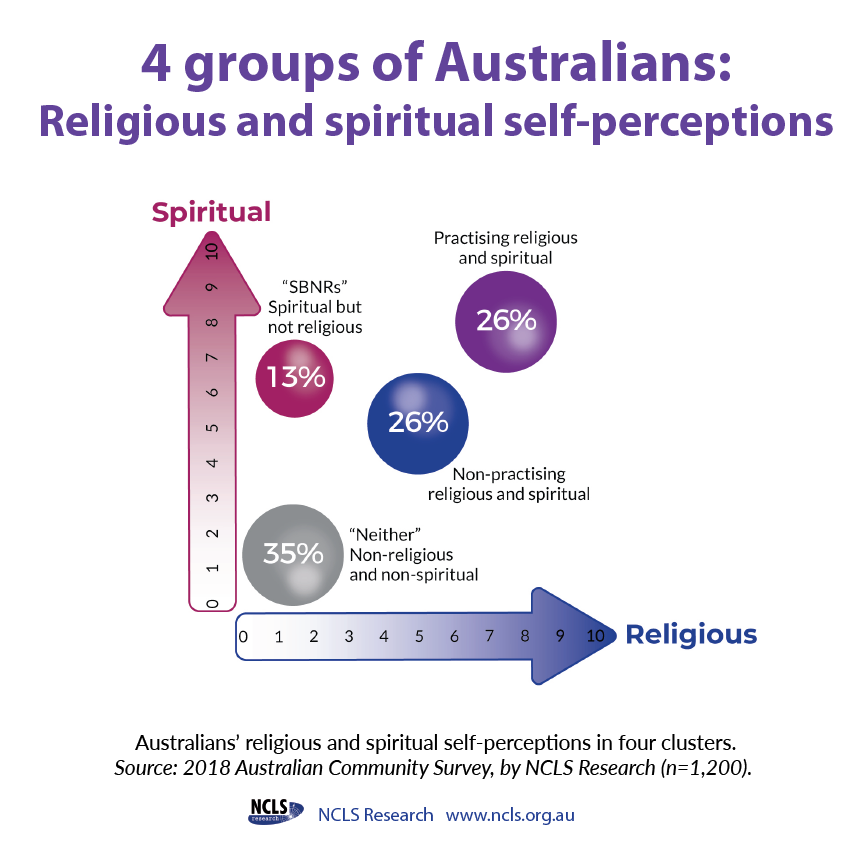Australians were asked: “To what extent do you see yourself as a religious person?” and “To what extent do you see yourself as a spiritual person?”.
Results reveal that Australians fall into four groups:
- Religious and spiritual (practising religious and spiritual);
- Moderately religious and spiritual (non-practising religious and spiritual);
- Spiritual but not religious; and
- Neither religious nor spiritual.
“Religiousness” and “spirituality” are terms which have different but overlapping meanings in popular language. Both concepts are concerned in some way with the sacred or the transcendent. While the distinctions are not hard and fast, there may be dichotomies between religiousness and spirituality on the basis of institutional versus personal scales of reference, and belief versus emotion and experience.
“Religious” tends to refer to adherence to a particular religion, including its practices, beliefs and communities of expression, whereas “spiritual” refers more to an appreciation of the sacred as well as personalised beliefs and practices.
On scales from 0 (not at all) to 10 (very), a sample of Australians were asked to indicate: “To what extent do you see yourself as a religious person?” and “To what extent do you see yourself as a spiritual person?”. There were widespread results in the ACS, on both religious and spiritual self-perceptions. Overall, respondents considered themselves to be a little more spiritual than religious.
The median response for religiousness was 4 on the 11-point scale, whereas it was 5 for spiritualness. The most common (modal) responses were “not at all religious” (36%) and “not at all spiritual” (24%). Just 4% considered themselves to be “very religious” and 7% “very spiritual”.


Australians fall into four clusters
Given the overlaps and distinctions between religiousness and spirituality, it is helpful to examine whether there are groups of people who answer the questions about religious and spiritual self-perceptions in similar ways. Other survey research has found that there is a group of people who consider themselves to be “spiritual but not religious”. For example, 14% of people in the 2017 Faith and Belief study indicated that they had spiritual beliefs but didn’t identify with any main religion (McCrindle, Renton, Phillips and Miles, 2017).
In the 2018 ACS, we used an empirical technique called cluster analysis on the responses to both the religious and spiritual self-perception questions. We found four groups of people, which are indicative of four general approaches to religion and spirituality in contemporary Australia.
The first two groups are religiously affiliated and see themselves as religious and spiritual. Yet they differ in terms of the degree of religiousness and spiritualness and whether or not they formally practise their religion, and so they have been labelled “practising” and “non-practising religious and spiritual”. These two groups are of equal size and, together, make up half of adult Australians.
The third (smallest) group emphasises spirituality (especially spiritual experience) but not adherence to, nor practice of a religion. We will use the short label, “SBNR”, which is used widely by other researchers to indicate those who are spiritual but not religious. The fourth (and largest) group is unaffiliated, atheist/agnostic and neither religious nor spiritual.
So, in summary, the four clusters are:
• Religious and spiritual: “Practising religious and spiritual”
• Moderately religious and spiritual: “Non-practising religious and spiritual”
• Spiritual but not religious: “SBNR”
• Neither religious nor spiritual: “Neither”.

Four clusters explained
As now detailed, each of these four clusters has its own distinct features in terms of religious affiliation as well as other dimensions of religiousness and spiritualness.
Practising religious and spiritual
This group (26% of respondents) saw themselves as both religious and spiritual, with mean scores of 8.0 and 8.3 respectively on the religiousness and spiritualness 11-point scales. Religious faith or spirituality tended to be "very important" to their life decisions. Almost all identified with a religion (79% Christian, 15% other religion). They believed in either a personal God (66%) or a higher power (30%). Religious service attendance varied widely in this group but on average it was monthly. Prayer or meditation was much more regular – a few times a week on average. Four in ten had had a mystical or supernatural experience.
Non-practising religious and spiritual
This group (26% of respondents) saw themselves as moderately religious (mean score of 5.2 on religiousness) and moderately spiritual (mean score of 5.0 on spiritualness). Religious faith or spirituality tended to be "important" to their decisions. A large majority identified with a religion (71% Christian, 11% other religion) and they mostly either believed in a higher power (42%) or a personal God (28%), with a quarter being agnostic. Religious service attendance on average was once a year, and prayer or meditation was occasional. Less than a quarter (22%) had had a mystical experience, but a third believed it could happen.
Spiritual but not religious: “SBNR”
This was the smallest group (13% of respondents). They saw themselves as spiritual (mean score of 6.5 on spiritualness) but not religious (mean score of 0.7), yet faith/spirituality tended to be “of little importance” to their decisions.
This group was largely unaffiliated and non-practising, the emphasis was rather on experiencing the sacred. The majority did not identify with a religion (64%) and half (54%) believed in a higher power while two in 10 were agnostic. They didn’t attend religious services and they rarely prayed or meditated. However, half (47%) had had a mystical or supernatural experience.
Non-religious and non-spiritual: “Neither”
This group (35% of respondents) saw themselves as neither religious nor spiritual (mean scores of 0.4 and 0.6 on religiousness and spiritualness respectively), and faith/spirituality tended to be "not important" to their life’s decisions. The majority did not identify with a religion (70%). They were either atheist (55%) or agnostic (29%). They didn’t attend services, pray or meditate, and the majority (56%) thought that mystical experiences don’t occur.
The most distinguishing feature to note
When people chose to identify how “religious” or “spiritual” they were, the terms were used in quite similar ways. While being spiritual as opposed to religious has gained attention in religious studies and in general commentary, a cluster analysis found that only 13% of Australians fitted a type which could be called “spiritual but not religious”. A more significant distinguishing feature is whether or not a person is practising or non-practising (26% each). Around a third of Australians were neither religious nor spiritual.



